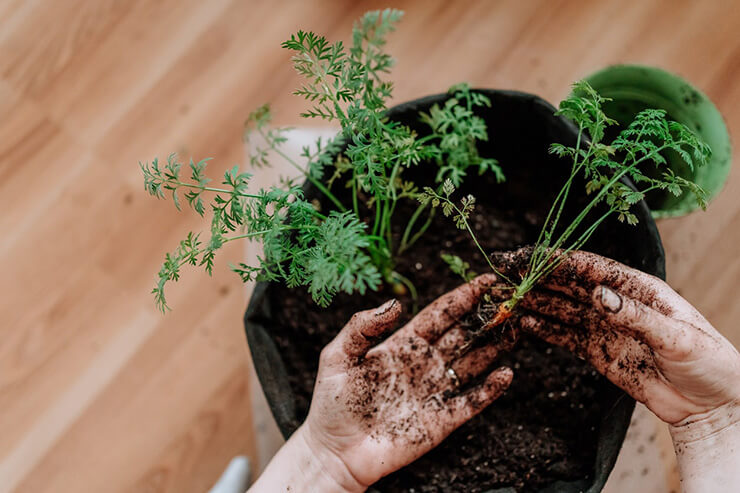Carrots (Daucus carota) are one of the most satisfying crops to grow indoors. Known for their earthy sweetness, cheerful color, and crunch, these humble root vegetables are not just for traditional backyard plots. With the right setup, carrots grow beautifully indoors—offering a harvest that’s both delicious and fun to dig up (even if it’s from a pot on your kitchen shelf).
Because carrots grow underground, they’re a bit different from leafy or fruiting crops. They don’t require pollination, they tolerate cooler temps, and they thrive in deep containers. With some patience and care, you can pull your own vibrant roots from a pot in just a few months—no matter the season.

Soil and pH Preferences
Getting the soil right is crucial for carrot success. These roots like to stretch out and grow smooth, so the soil needs to be light, loose, and free of obstacles.
- Preferred pH:Aim for a slightly acidic to neutral range, ideally between 0 and 6.8.
- Soil Blend:Use a lightweight potting mix combined with sand or coconut coir to ensure it stays well-aerated. Avoid heavy, clay-like soils that restrict root growth or cause carrots to split.
- Additions:A little bit of compost or worm castings can offer slow-release nutrients without creating excess nitrogen, which encourages leafy tops over root development.
Light Needs
Although the carrot root grows underground, the leafy top needs adequate light to photosynthesize and fuel root development.
- Light Duration:Provide at least 10 to 12 hours of strong light
- Lighting Options:Full-spectrum LED grow lights are ideal, especially during darker months. Position them 6-10 inches above the leaves and adjust as the plants grow.
- Window Placement:A sunny windowsill, preferably south-facing, can also work for the leafy greens, though supplemental light will give you the best results indoors.
Watering Habits
Carrots rely on consistent moisture to develop plump, straight roots. Uneven watering can result in woody texture or cracked roots.
- Moisture Routine:Keep the soil gently moist but not saturated. Water when the top inch feels dry to the touch.
- Best Practices:Water deeply and evenly. A self-watering container or bottom-watering system can help maintain stable moisture levels.
- Humidity Consideration:Normal indoor humidity (40-60%) is just fine. Overly dry air can be offset by grouping plants together or placing a shallow water dish nearby.
Best Indoor Conditions
Carrots don’t take up much space above the surface, but they need depth to grow well below.
- Container Depth:Choose a pot that’s at least 8 to 12 inches deep, depending on the variety.
- Temperature:Carrots prefer cooler environments—ideally between 60-70°F (15-21°C). Too much warmth can cause bitterness.
- Spacing:Sow seeds densely and thin seedlings to about 2 inches apart. Overcrowding leads to small or misshapen roots.
- Air Flow:While not particularly fussy, carrots do benefit from some air circulation to prevent mold near the tops.
Carrot Varieties That Shine Indoors
From lunchboxes to roasting pans, carrots are as versatile as they are vibrant. They’re one of the few root crops that come in a rainbow of colors—orange, yellow, purple, red, and even white—and each has its own subtle flavor notes. Indoors, shorter carrot types perform especially well, making it easy to grow a variety in a small space.
Let’s look at five standout varieties that excel in indoor environments, along with the best ways to enjoy each.
Romeo
Romeo is a small, spherical carrot with a sweet and tender bite. Because it forms a round root rather than a long taproot, it’s perfect for pots with limited depth.
Indoor-Friendly Features:
- Round roots grow well in just 6 inches of soil
- Fast-growing and forgiving
- Fun for kids and first-time growers
How to Use It:
- Excellent raw for dipping or snacking
- Looks great roasted whole with herbs
- Try pickling for a crunchy twist
Little Finger
As the name suggests, this baby carrot type produces slim, cylindrical roots about 4 inches long. It matures quickly and is ideal for container gardening.
Indoor-Friendly Features:
- Compact size works well in tighter containers
- Smooth texture and mild sweetness
- Quick turnaround—often ready to harvest in under 60 days
How to Use It:
- Ideal for raw snacking or juicing
- Use in stir-fries or light sautés
- Great for spiralizing into veggie noodles
Mokum
Known for its incredible sweetness, Mokum is a Dutch variety often considered one of the tastiest carrots available. It has a slim, blunt tip and grows to about 6 inches.
Indoor-Friendly Features:
- High sugar content makes it an indoor treat
- Grows quickly and evenly
- Performs well in deep window boxes or long containers
How to Use It:
- Raw in salads or wraps
- Blend into smoothies for natural sweetness
- Bake into carrot muffins or cake
Atlas
Atlas carrots are globe-shaped, similar to Romeo but slightly larger. They’re great for growing in small containers and offer a robust, earthy flavor.
Indoor-Friendly Features:
- Only requires 5-6 inches of soil depth
- Unusual shape makes it decorative as well as tasty
- Less prone to splitting than long carrots
How to Use It:
- Delicious roasted with garlic and olive oil
- Add to stews or pot roasts whole
- Pairs beautifully with cumin or citrus glazes
Nelson
Nelson is a Nantes-style carrot, meaning it has a blunt tip, smooth texture, and strong, sweet flavor. Though longer than some dwarf varieties, it’s still suitable for deeper indoor containers.
Indoor-Friendly Features:
- Uniform shape makes harvesting easier
- Strong tops make it easy to pull from soil
- Performs well in 10-inch-deep pots
How to Use It:
- Perfect for slicing into soups and stocks
- Grate for use in salads or carrot slaw
- Roast and serve with balsamic glaze or honey


 Previous
Previous

